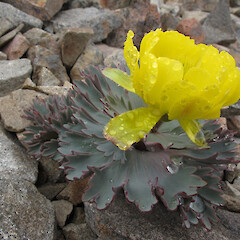Ranunculus acraeus
Synonyms
None - first described December 2006.
Family
Ranunculaceae
Flora category
Vascular – Native
Endemic taxon
Yes
Endemic genus
No
Endemic family
No
Structural class
Herbs - Dicotyledons other than Composites
Current conservation status
The conservation status of all known New Zealand vascular plant taxa at the rank of species and below were reassessed in 2017 using the New Zealand Threat Classification System (NZTCS) – more information about this can be found on the NZTCS website. This report includes a statistical summary and brief notes on changes since 2012 and replaces all previous NZTCS lists for vascular plants.
Please note, threat classifications are often suggested by authors when publications fall between NZTCS assessment periods – an interim threat classification status has not been assessed by the NZTCS panel.
- Conservation status of New Zealand indigenous vascular plants, 2017 . 2018. Peter J. de Lange, Jeremy R. Rolfe, John W. Barkla, Shannel P. Courtney, Paul D. Champion, Leon R. Perrie, Sarah M. Beadel, Kerry A. Ford, Ilse Breitwieser, Ines Schönberger, Rowan Hindmarsh-Walls, Peter B. Heenan and Kate Ladley. Department of Conservation. Source: NZTCS and licensed by DOC for reuse under the Creative Commons Attribution 4.0 International licence.
2017 | Threatened – Nationally Endangered | Qualifiers: DP, RF
Previous conservation statuses
2012 | Threatened – Nationally Endangered | Qualifiers: DP
2009 | Threatened – Nationally Endangered | Qualifiers: DP
2004 | Not Threatened
Distribution
Endemic. South Island, North Otago (Barrier Range, St Marys Range, St Bathans Range, Kakanui Mountains and Ida Range) and in south-west Canterbury (Hall Range, Godley River valley).
Habitat
A high alpine species of stable, coarse rock-fields of greywacke and non-foliated schist.
Detailed description
Robust, summer-green, rhizomatous herb, up to 40 cm high, forming patches up to 1 m across. Rhizomes numerous, stout, 10–12 mm diameter, regularly branched. Lamina 60–75 × 75–130 mm, broadly reniform or broadly orbicular, grey to grey-green, sparsely covered with pilose hairs, glabrate or glabrous, divided into 3 primary segments; margin crenate, teeth 2–9 mm long, broadly obovate, oblong to broadly oblong, apices obtuse, margin red; petiole 50–250 × 5–9 mm, fleshy, terete; sheath 15–40 mm, moderately to densely covered with pilose hairs. Inflorescence 80–400 × 5–14 mm, yellow-green to green, terete, with 1–6 flowers, each flower subtended by a leafy bract. Bracts similar to leaves, sessile, smaller toward distal flowers. Peduncles glabrous. Flowers 40–50 mm diameter. Sepals 6–7, 20–22 × 8–11 mm, yellow-green to light green, oblong, oblong-elliptic or broadly elliptic, hairy on abaxial surface, glabrous on adaxial surface. Petals 16–27, 22–27 × 5–13 mm, yellow, narrowly to broadly oblanceolate, apex obtuse, nectary a simple pit. Stamens 110–139, glabrous; filament 1.6–8.5 × 0.7–1.4 mm, translucent; anthers 1.8–2.8 mm long, cream. Carpels 126–171. Achenes 6.4–7.3 × 2.7–3.4 mm, yellow-brown; beak curved to ventral side, laterally compressed, tapering toward a point at apex.
Similar taxa
Closest to R. piliferus (F.J.F.Fisher) Heenan et P.J.Lockhart from which it is can be distinguished by its finely crenate leaf and bract margins, glabrous peduncle; by the 6-7 abaxially hairy, adaxially glabrous sepals, and allopatric distribution.
Flowering
November - January
Flower colours
Green, Yellow
Fruiting
December - January
Propagation technique
Difficult. Should not be removed from the wild.
Threats
Uncommon. Known from c.200 plants on St Marys Range, 2 plants each on the Barrier Range and Hall Range, and an unknown number of plants at the other localities which are based on old herbarium specimens. At all recently visited sites plants are at risk from or are browsed by Thar and Chamois. Because it is a high alpine, and has been confused in past literature with other more common species, this species threat status is qualified as Data Poor (DP)
Etymology
ranunculus: From the Latin ‘rana’ frog, meaning little frog and probably refers to the plants typical marshy habit where frogs abound
Where To Buy
Not commercially available
Notes on taxonomy
It is further distinguished from R. piliferus on molecular (DNA) grounds (see Heenan et al. (2006; N.Z.J.Bot. 44: 425-441.)
Attribution
Fact Sheet prepared for NZPCN by P.J. de Lange (30 October 2008). Description by P.B. Heenan based on Heenan et al. (2006).
References and further reading
Heenan, P.B; Lockhart, P.J.; Kirkham, N.; McBreen, K.; Havell, D. 2006: Relationships in the alpine Ranunculus haastii (Ranunculaceae) complex and recognition of R. piliferus and R. acraeus from southern New Zealand. New Zealand Journal of Botany 44: 425–441.
NZPCN Fact Sheet citation
Please cite as: de Lange, P.J. (Year at time of access): Ranunculus acraeus Fact Sheet (content continuously updated). New Zealand Plant Conservation Network. https://www.nzpcn.org.nz/flora/species/ranunculus-acraeus/ (Date website was queried)







